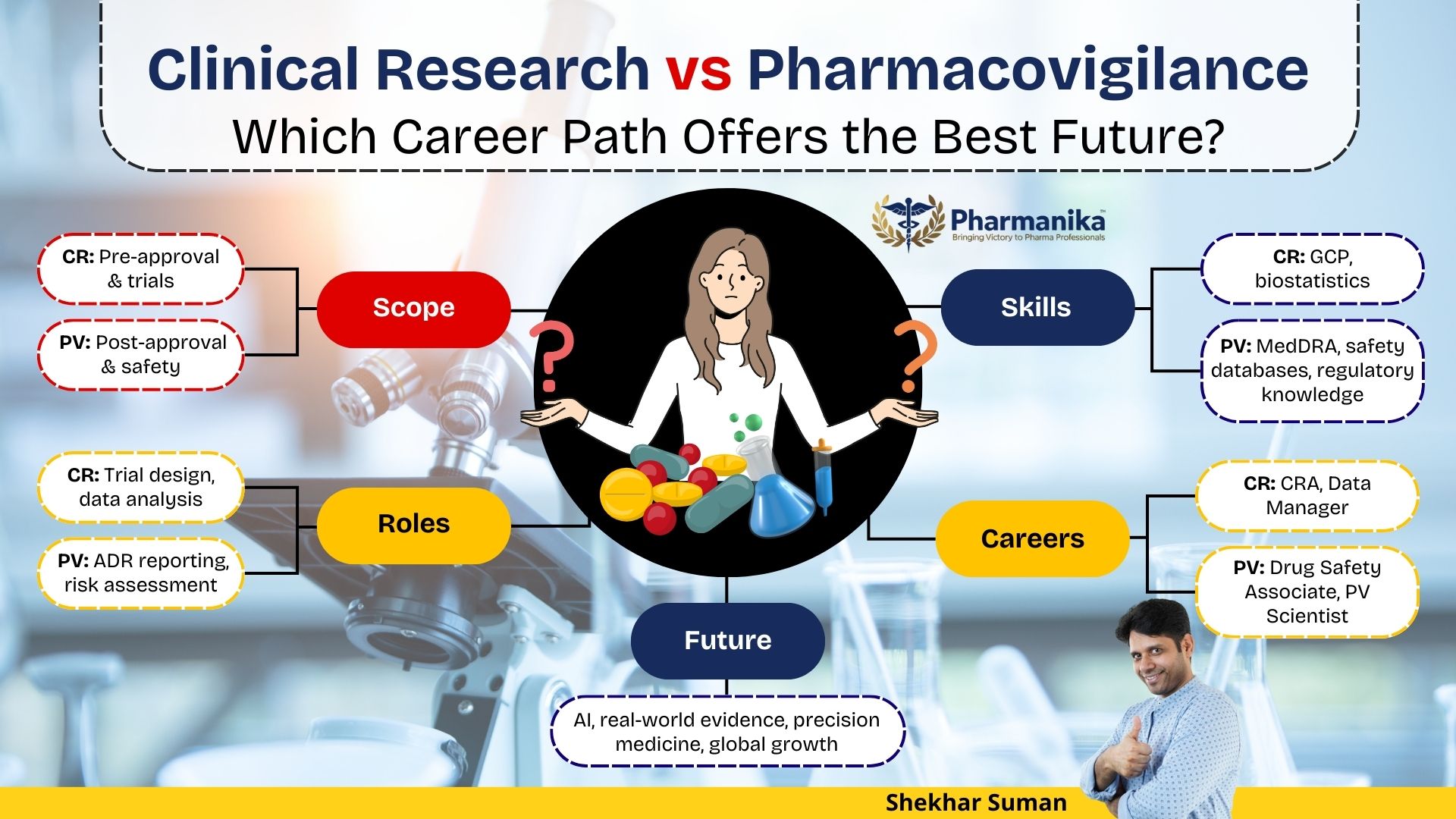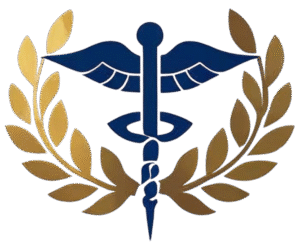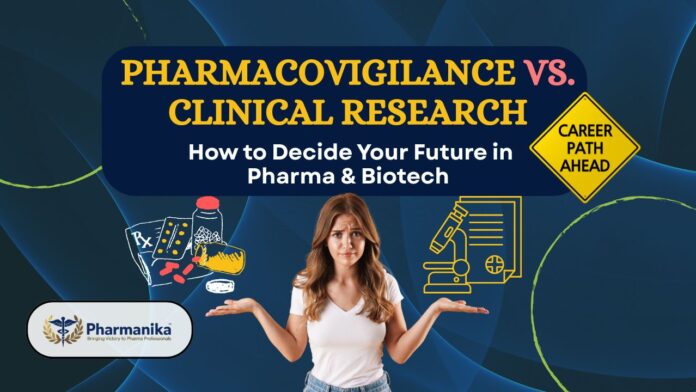Clinical Research & Pharmacovigilance: Which Career Path Should You Choose?
Anukriti Nath had just graduated from college with an MTech (Master of Technology) degree in Biotechnology. Soon after graduating, she found herself stuck in a Professional dilemma similar to many of her classmates. It was about deciding on a career that would eventually make a difference and impact human health and the Healthcare sector.
On a usual day, while browsing the opportunities, she came across an article that talked about an unusual ADR (Adverse Drug Reaction) effect associated with a commonly prescribed medicine. She learned how Clinical Trials rigorously test new therapies before patients receive them. In that moment, she realized the two critical pillars of Healthcare: Clinical Research & Pharmacovigilance. PV (Pharmacovigilance), which protects patients from potential drug risks, and CR (Clinical Research), which develops and validates life-saving treatments.
A successful career in Life Sciences is filled with numerous possibilities and achievements. However, your passion could lie in enhancing Life Sciences and Healthcare; deciding the correct career path for oneself could be daunting. Clinical Research or Pharmacovigilance, which path is appropriate with your long-term goals, skills, as well as interests can be challenging to decide. These fields are expanding on a global level, offering incredible opportunities and having a highly impactful effect. However, each career path requires a unique set of skillsets, strengths, as well as expertise.
This article on Clinical Research & Pharmacovigilance aims to provide an insightful comparison between these career paths. It highlights the skill requirements, career roles, expanding opportunities, as well as key responsibilities.
Whether your goal is to develop new therapies or protect patients through vigilant monitoring, this guide provides actionable insights to help shape your professional journey. This article explores Clinical Research & Pharmacovigilance, comparing their career growth, scope, as well as skills.
What is Pharmacovigilance?
PV or Pharmacovigilance is a field of Science that assesses, prevents, as well as monitors ADRs of medications. The key responsibility of a PV professional is to ensure that the medicines prescribed to patients remain effective, beneficial, as well as safe throughout their drug lifecycle, globally.
Key responsibilities of PV include:
- Conducting risk assessment and signal detection
- Analysis and collection of ADR reports
- Ensuring Regulatory compliance with PV Regulations globally
- Preparation of safety updates and Regulatory reports
For instance, during the rollout of the Corona/COVID-19 vaccine, PV professionals rigorously monitored and analysed real-world safety data. That ensured quick detection of any rare adverse events, thereby protecting millions of patients worldwide.
In essence, PV professionals act as guardians of patient safety, ensuring that medicines continue to do more good than harm.
What is Clinical Research?
Clinical Research focuses on testing new drugs, therapies, or Medical Devices in human participants to evaluate their safety, efficacy, and overall benefit-risk profile before approval.
Core responsibilities include:
- Designing and managing Clinical Trials (Phases I–IV)
- Recruiting and monitoring study participants
- Collecting, analyzing, and interpreting clinical data
- Ensuring adherence to Good Clinical Practice (GCP) guidelines
For instance, the development of COVID-19 mRNA vaccines depended on skilled and experienced CR professionals. They conducted multi-phase Clinical Trials globally and ensured the efficacy and safety of drugs before public administration worldwide.
CR professionals’ primary responsibility is to ensure that novel therapeutics are Scientifically and Clinically validated, ready for approval, as well as ethically tested.
Clinical Research & Pharmacovigilance: A Comparative View
| Aspect | Pharmacovigilance (PV) | Clinical Research (CR) |
| Focus | Monitoring the safety of approved drugs | Testing therapies, medical devices, or novel drugs |
| Stage of Involvement | Post-marketing | Pre-approval and Clinical Trials |
| Primary Responsibility | Ensure ongoing safety and minimise risks | Assess efficacy, therapeutic, and safety outcomes |
| Workplace | Pharmaceuticals, CROs, Regulatory authorities | Pharmaceuticals, CROs, hospitals, and Research institutes |
| Key Skills | Drug safety Regulations, MedDRA coding, Regulatory reporting, and signal detection | Biostatistics, Clinical Trial management, Data Analysis, patient monitoring |
Career Opportunities
Pharmacovigilance
The Pharmacovigilance market is projected to grow at a CAGR (Compound Annual Growth Rate) of 7-13% between the years 2023 and 2030. This growth is fueled by increased Biologics approvals as well as stricter safety Regulations. Common PV roles include:
- PV Scientist
- Drug Safety Associate
- Signal Detection Specialist
- PV Compliance Manager
- Medical Reviewer
PV career growth leads to senior leadership roles in Regulatory Affairs, risk management, as well as global safety.
Clinical Research
The global Clinical Trials market is expected to reach approximately $90 billion by the year 2034. It will be driven by advancements in Immunology, Gene Therapies, as well as Oncology. Clinical Research career roles include:
- Clinical Data Manager
- CRA (Clinical Research Associate)
- Regulatory Affairs Specialist
- Biostatistician
- Clinical Trial Coordinator
Long-term Clinical Research growth can lead to career roles like Director of Clinical Operations, Principal Investigator, or Clinical Project Manager.
Together, Clinical Research & Pharmacovigilance are fueling global job demand across Life Sciences.
Skills Required
| Skill Area | Pharmacovigilance | Clinical Research |
| Technical Knowledge | Drug safety Regulations, MedDRA coding, safety databases | GCP, Clinical Trial protocols, Biostatistics |
| Regulatory Awareness | Global PV Laws, risk management plans, PSUR/DSUR preparation | FDA/EMA guidelines, Ethics committee |
| Analytical Skills | Signal detection, risk–benefit assessment | Data interpretation, patient outcome evaluation |
| Communication Skills | Regulatory submissions, safety reports, and global agency interactions | Collaboration with investigators, site staff, and Ethics committees |
| Personal Traits | Attention to detail, patience, and critical thinking | Adaptability, project management, problem-solving, teamwork |
Flow of Work: Clinical Research and Pharmacovigilance
Understanding the Drug lifecycle would clarify how these two careers fit:
- Clinical Research → Pre-Approval Stage → (Trial design, data collection, patient recruitment, Regulatory submission, Ethical Compliance) → Market Launch
- Pharmacovigilance → Post-Approval Stage → (global safety reporting, risk–benefit analysis, adverse event monitoring) → Patient Protection
CR lays the foundation and groundwork for novel therapies. PV ensures drug safety for the medications. Altogether, these two career roles form a schematic loop of innovation and safety, each equally essential for the Healthcare and Life Sciences sectors.

Which Career To Choose?
The best path depends on your skills, interests, and long-term goals:
- You should choose CR if you have a passion for Clinical Trials, Scientific innovation, and like patient interaction.
- You should choose PV if you thrive on writing reports, safeguarding patient safety, as well as analyzing datasets.
The bottom line is that Clinical Research professionals innovate, while Pharmacovigilance professionals safeguard the Drug.
Future Outlook
Technology, data, and patient-centered Healthcare will redefine Clinical Research & Pharmacovigilance, opening new opportunities for professionals.
- Clinical Research: Wearable devices, Precision Medicine, and Decentralized trials will enable targeted, faster, as well as more accessible studies.
- Pharmacovigilance: Real-world and AI (Artificial Intelligence) data would enhance safety monitoring, while patient reporting would make drug safety more proactive and effective.
- Converging Roles: CR and PV will increasingly overlap in the coming times, with professionals utilizing both Clinical Trial and real-world data to improve patient outcomes globally.
Both these two fields would evolve and grow, generating career opportunities for skilled professionals to become innovative and strategic contributors in the Healthcare and Life Sciences sector.
Conclusion
Clinical Research & Pharmacovigilance are two critical pillars of the Healthcare and Pharmaceutical sectors, each playing an essential role in ensuring the efficacy of treatments. Clinical Research drives innovation, bringing new therapies to life, while Pharmacovigilance safeguards patient well-being in the real world.
Choosing between them is not about which is better; it’s about aligning your career with your aspirations, strengths, and interests.
If you aspire to contribute to Clinical Trials, developing novel therapeutics, as well as like patient interaction, then Clinical Research could be the perfect career. If you like mitigating risks and analyzing data, Pharmacovigilance could be your dream career.
By choosing either path, you are stepping into a rewarding, future-proof, as well as dynamic career path. You’ll be contributing directly to Science advancements, transforming Healthcare, as well as improving patient lives worldwide.
In short, protecting lives or creating life-saving therapies is a career worth pursuing with pride and purpose.
Frequently Asked Questions (FAQs)
01 Is Pharmacovigilance a better career than Clinical Research?
-> PV suits those who enjoy data and safety oversight, while CR fits those passionate about therapy development and Clinical Trials.
02 Do these careers offer international opportunities?
-> Yes. Both these career fields have strong global demand, especially in the EU, the US, the UK, India, and Singapore.
03 What is the salary potential in these fields?
-> Entry-level salaries in India: CR: ₹3.5–7 Lacs Per Annum; PV – ₹3–6 Lacs Per Annum. Senior roles globally can exceed ₹25 Lacs Per Annum, depending on skills, location, and experience.
04 Which skills are most in demand?
-> For Pharmacovigilance: risk assessment, signal detection, and Regulatory knowledge.
For Clinical Research: patient monitoring, Clinical Trial Management, project coordination, and Biostatistics.
05 Can professionals transition between CR and PV?
-> Yes. Professionals with Clinical Trial experience can move into PV and vice versa, utilizing Data Analysis skills and Regulatory knowledge.






